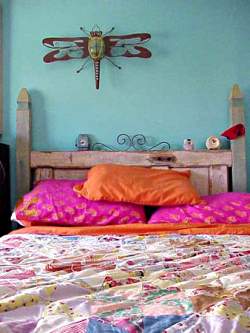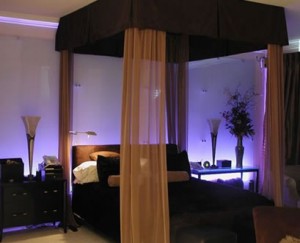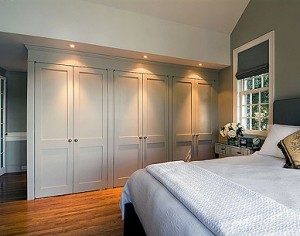When selecting a color scheme for your bedroom, let personal taste guide you rather than current trends. If the bedroom is predominantly one color, vary the textures to add interest; for example, combine a smooth, crisp chintz fabric with a textured linen.
 Keep in mind that walls, floors and other elements in a bedroom also have textures that add to the ambience of a room. A smooth brass headboard contrasts nicely with a tapestry bedspread. Polished hardwood flooring provides a beautiful surface that sets off a plush area rug perfectly. Effectively combining patterns to create a desired bedroom decor can be a bit confusing and somewhat intimidating. Today, many textile manufacturers are making things easier for their customers by offering such coordinating elements as fabric and wallpaper together, to make the whole process easier.
Keep in mind that walls, floors and other elements in a bedroom also have textures that add to the ambience of a room. A smooth brass headboard contrasts nicely with a tapestry bedspread. Polished hardwood flooring provides a beautiful surface that sets off a plush area rug perfectly. Effectively combining patterns to create a desired bedroom decor can be a bit confusing and somewhat intimidating. Today, many textile manufacturers are making things easier for their customers by offering such coordinating elements as fabric and wallpaper together, to make the whole process easier.
One way to successfully combine patterns is to use one fairly large design and contrast it with a geometric pattern, such as stripes, a plaid, checks or even polka dots. The patterns should coordinate with each other through color or tone with subtle contrasts of scale or proportion. It is best not to use more than one large-scale design in a room. Try using several different small-scale patterns with a larger design.
Patterns are incorporated into design schemes in a few different ways. One way is to use plain, unpatterned walls, windows and furnishings with muted colors to keep the look simple. A Shaker motif would be one example. Another approach is to use pattern throughout, on the windows, the walls, even on the furnishings.
When mixing patterns in a bedroom, use only one bold pattern throughout so that it dominates the design. You can then begin adding smaller-scale patterns and prints. A third choice is to use patterns with plain color together for a balanced look. A larger pattern on a window treatment or walls gives the room a sense of balance if other items in the room, such as the blinds, upholstery, pillows or cushions, are kept as simple as possible.
Similar designs in the same colors work well together, as do similar designs in two different colors. An exception to the rule of not using too many patterns together can be made with patterns that have similar color and scale of design, such as plaids or paisleys.
 Make your living room more romantic, increase the wattage of the light bulbs to 100 or 150. (It’s essential that your lamps are labeled to accept this wattage; if not, they’ll need rewiring, which may cost about $30.) Then install dimmer switches and dial the brightness down. You’ll get a golden-yellow light that encourages intimate conversations.
Make your living room more romantic, increase the wattage of the light bulbs to 100 or 150. (It’s essential that your lamps are labeled to accept this wattage; if not, they’ll need rewiring, which may cost about $30.) Then install dimmer switches and dial the brightness down. You’ll get a golden-yellow light that encourages intimate conversations.
 Keep in mind that walls, floors and other elements in a bedroom also have textures that add to the ambience of a room. A smooth brass headboard contrasts nicely with a tapestry bedspread. Polished hardwood flooring provides a beautiful surface that sets off a plush area rug perfectly. Effectively combining patterns to create a desired bedroom decor can be a bit confusing and somewhat intimidating. Today, many textile manufacturers are making things easier for their customers by offering such coordinating elements as fabric and wallpaper together, to make the whole process easier.
Keep in mind that walls, floors and other elements in a bedroom also have textures that add to the ambience of a room. A smooth brass headboard contrasts nicely with a tapestry bedspread. Polished hardwood flooring provides a beautiful surface that sets off a plush area rug perfectly. Effectively combining patterns to create a desired bedroom decor can be a bit confusing and somewhat intimidating. Today, many textile manufacturers are making things easier for their customers by offering such coordinating elements as fabric and wallpaper together, to make the whole process easier.


